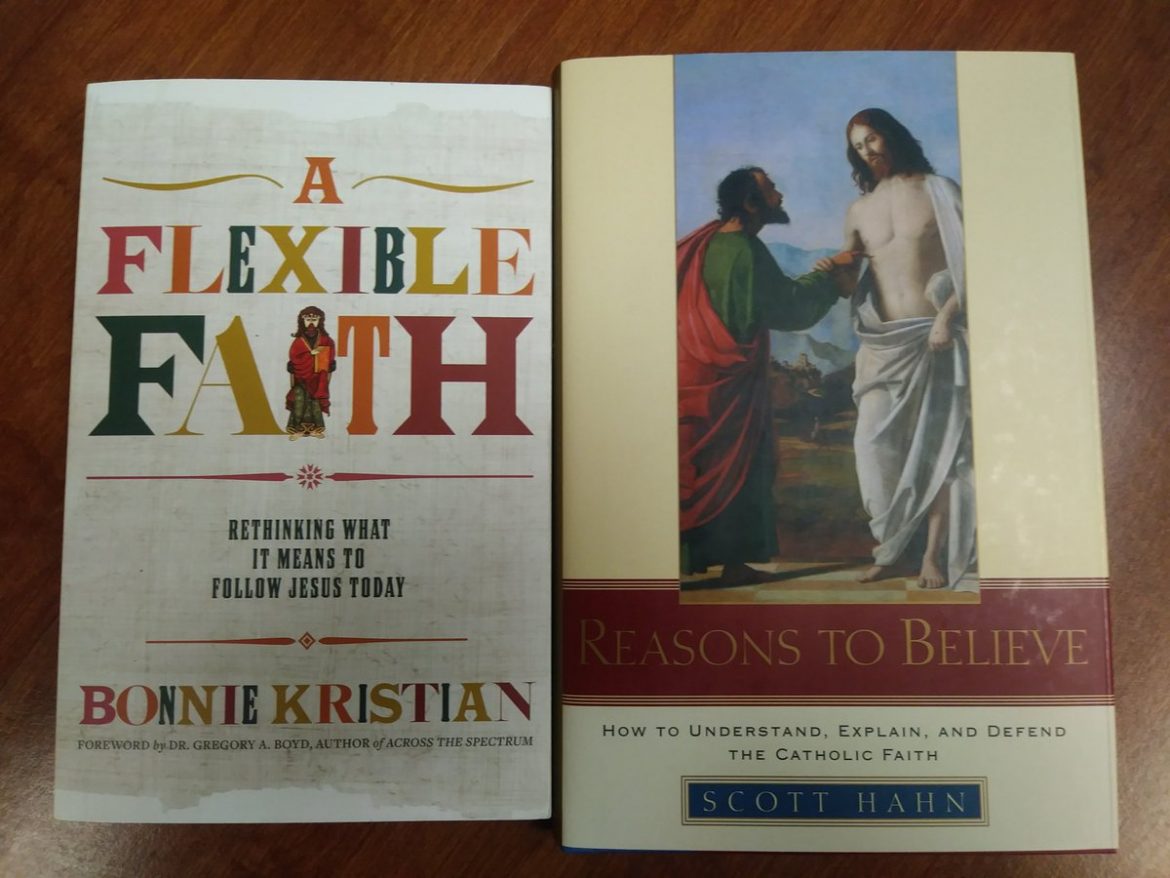The true doctrine surely is this – that we respect the creeds held by others because there is some good in them,
not because they are creeds and are held. In other words, an honest man must always respect other religions,
because they contain parts of his religion – that is, of his largest vision of truth.
– G.K. Chesterton (1910)
Author: Bonnie Kristian
Publisher: FaithWords
Genre: Theology
Reading Level: Adult
My Rating: 7 of 10
Can a Catholic believe in A Flexible Faith? That is the question that ran through this reviewer’s mind upon setting out to read the first published book of theological and political writer Bonnie Kristian. A book with a promising and timely premise in an era where the secular world seems to be uniting in opposition to Christianity.
A work that is more ecumenical than theological in nature, it fits into a vein similar to C.S. Lewis’s Mere Christianity in that it seeks to build bridges between the different sects of the Christian Faith so as to help Christians find common ground and work together. One of its strongest assets in seeking to accomplish this is in avoiding cliches about what the different Christian faiths believe on certain issues. Instead Kristian seeks to clearly and succinctly define what certain different teachings of these faiths are, through quoting directly from source documents as to what they believe. (For example, in laying forth Catholic teachings, she quotes directly from the Catechism of the Catholic Church whenever possible).
Another strong asset the book possesses is the interviews Kristian does with members of different faith communities. In these interviews she allows them to explain their faiths and ways of life in their own words. This also helps strip away some of the cliches surrounding these different practices and sets of beliefs. This then improves the ability for Christians of different faiths to dialogue with, and understand each other, even if they do not agree theologically on certain points.
Finally, in one of the most appreciated aspects of the whole book, Kristian lays out her own views on those issues she addresses where she possesses a strong or researched view. This practice helps the reader understand where Kristian’s bias is coloring her analysis of different perspectives of certain views and teachings. Though one could easily disagree with Kristian’s views of these questions, the fact that she lays them out for the reader is very much appreciated. This enables the reader to be inclined to look more closely into views Kristian might not speak as highly or as in-depth about.
The book could use improvements in some areas. Her research of the other Christian faiths, though very commendable in relying on primary sources written by members of the faiths in question, may come across as incomplete in some small areas to members of those other Faiths. For example, in Chapter 6 she accurately lists the seven Catholic sacraments but makes a small error in describing Holy Orders as consisting of ‘priests, monks and nuns’. The Catholic sacrament of Holy Orders consists of priests only, as priests are empowered through Holy Orders with the ability to transform bread and wine into the Body and Blood of Christ. Monks and nuns are merely individuals who have become members of religious orders, and so have freely professed vows to follow God individually or in community by a certain set of rules.
One significant absence in the book is of a chapter dealing solely with the differences in definitions of certain religious terms among the different Christian sects. For example, Catholics and other Christians have vastly different definitions and understandings of the word ‘worship’. This difference in definition and understanding can lead to some significant breakdowns in dialogue as non-Catholic Christians are led to believe that Catholics do such things as ‘worship Mary the Mother of God’. The reality is, however, Catholics revere Mary rather than worship her, as their definition of ‘worship’ revolves around sacrifice rather than simply reverence. Non-Catholic Christians, on the other hand, define ‘worship’ in more reverence-oriented ways, thus leading to the root of the misunderstanding between the different Christian faiths. Those who hold to the reverence definition of worship would obviously be led to believe Catholics worship Mary through their reverence of her when, under the Catholic definition of worship as sacrifice, Catholics are doing nothing of the kind. They are only affording her the reverence she is owed as the one who undertook the great responsibility of being the Mother of the Savior. This, and many other misunderstandings between the different Christian sects, have their roots in definitions. A chapter dealing with those differences and encouraging dialogue on definitions would be a constructive addition in possible later editions of Kristian’s work.
There are a variety of good theological images interspersed with other smaller weaknesses throughout the work as well. For example, Kristian’s use of a theological analogy (taught her by a theologian she follows) of concentric circles to differentiate between doctrines, dogmas, traditions and opinions is an excellent visual picture for the everyday believer. However the weakness in the analogy lies in the fact that her list of doctrines in the non-negotiable circle are far too small. There are more doctrines that lie within that non-negotiable circle without which one cannot consider themselves a true Christian. The book is full of these instances, with good ideas tainted with small weaknesses, but the ideas themselves are excellent starting points from which to build constructive dialogue.
Overall this book is an excellent and timely read, but one where second, third and even fourth editions might be wise in the years to come as understandings of the different faiths discussed, as well as the teachings of the Church Fathers, are enhanced by the author. Additional chapters, such as the one recommended in dealing with the differences in religious definitions, would also enhance the power of what Kristian wishes to accomplish in promoting dialogue, understanding, and respect among the different Christian sects.
For Catholics, this reviewer does recommend A Flexible Faith but with words of advice. They should be comfortable in defending their Faith and in having a well-rounded understanding of their own Faith before engaging both in the book and in dialogue with members of other faiths so that their dialogue may be more constructive than divisive. After all, one could hardly explain what they do not truly know. To enhance the ecumenically constructive aspects of Kristian’s work, Catholics should read this book in tandem with one of the great spiritual works on Catholic beliefs: Dr. Scott Hahn’s Reasons to Believe. A work which provides a deeper theological and philosophical understanding of where the Catholic Church comes from on many (though not all) of the issues Kristian tackles in her own book.
(This is the first review of a set of books the reviewer recommends as an ecumenical tandem to promote constructive
dialogue between Christians. Please continue with the reviewer’s coverage of the second book of this tandem here.)
© 2018 Grant Dahl & On This Terrestrial Ball. All rights reserved. This material may not be re-published, re-broadcast, re-written or re-distributed without permission from the author of this piece.




